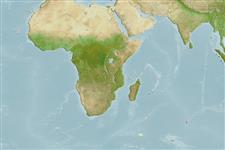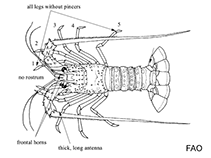Jasus paulensis (Heller, 1862)
St. Paul rock lobster| Native range | All suitable habitat | Point map | Year 2050 |

|
| This map was computer-generated and has not yet been reviewed. |
| Jasus paulensis AquaMaps Data sources: GBIF OBIS |
Upload your photos
Google image | No image available for this species;
drawing shows typical species in Palinuridae.
Google image | No image available for this species;
drawing shows typical species in Palinuridae.
Classification / Names Common names | Synonyms | CoL | ITIS | WoRMS
Malacostraca | Decapoda | Palinuridae
Environment: milieu / climate zone / depth range / distribution range Ecology
Benthic; depth range 0 - 200 m (Ref. 4), usually 10 - 40 m (Ref. 4). Temperate, preferred 15°C (Ref. 107945); 25°S - 47°S, 13°W - 99°E (Ref. 107486)
Distribution Countries | FAO areas | Ecosystems | Occurrences | Introductions
Southeast Atlantic, Western and Antarctic Indian Ocean.
Length at first maturity / Size / Weight / Age
Maturity: Lm 6.3, range 6 - 7.5 cm Max length : 37.0 cm TL male/unsexed; (Ref. 4); 27 cm TL (female); common length : 28.0 cm TL male/unsexed; (Ref. 4); common length :21 cm TL (female)
The total body length of largest specimen ever recorded is 37 cm; and the total body length is 14 to 35.5 cm (male) and 9 to 27 cm (female); and carapace lengths of 6 to 14.5 cm (male) and 4 to 10 cm (female); with an average size of 21 to 28 cm (male) and 19 to 21 cm (female). The specimens from Amsterdam are slightly smaller than those from St Paul Island (Ref. 4).
Life cycle and mating behavior Maturity | Reproduction | Spawning | Eggs | Fecundity | Larvae
May exhibit gynandromorphy (Ref. 10623). Egg-laying starts in May, and ovigerous females have been observed until November, or exceptionally early December. Females are caught from May to October, while males dominate in most catches from November to April (Ref. 4).
Main reference
References | Coordinator | Collaborators
Holthuis, L.B. 1991. (Ref. 4)
IUCN Red List Status (Ref. 130435: Version 2024-1)
Data deficient (DD) ; Date assessed: 07 April 2011
CITES status (Ref. 108899)
Not Evaluated
CMS (Ref. 116361)
Not Evaluated
Threat to humans
Human uses
Fisheries: commercial
FAO - Fisheries: landings | FishSource | Sea Around Us
Tools
More information
Trophic Ecology
Ecology
Population dynamics
Life cycle
Distribution
Human Related
Aquaculture profile
Stamps, Coins Misc.
Stamps, Coins Misc.
Outreach
Taxonomy
References
Internet sources
BHL | BOLD Systems | CISTI | DiscoverLife | FAO(Fisheries: ; publication : search) | Fishipedia | GenBank (genome, nucleotide) | GloBI | Gomexsi | Google Books | Google Scholar | Google | PubMed | Tree of Life | Wikipedia (Go, Search) | Zoological Record
Estimates based on models
Preferred temperature
(Ref. 115969): 5.5 - 15.3, mean 10.2 (based on 4 cells).
Resilience
(Ref. 69278):
Low, minimum population doubling time 4.5 - 14 years (K=0.06-0.11).
Nutrients : Calcium = 109 [35, 184] mg/100g; Iron = 1.59 [1.21, 1.97] mg/100g; Protein = 20.2 [19.2, 21.3] %; Omega3 = 0.285 [0.185, 0.386] g/100g; Selenium = 48.3 [-31.7, 128.3] μg/100g; VitaminA = 0 μg/100g; Zinc = 1.79 [1.17, 2.40] mg/100g (wet weight); based on nutrient studies.



